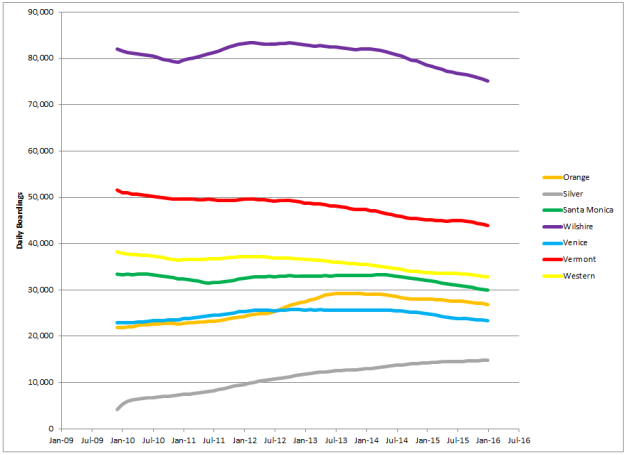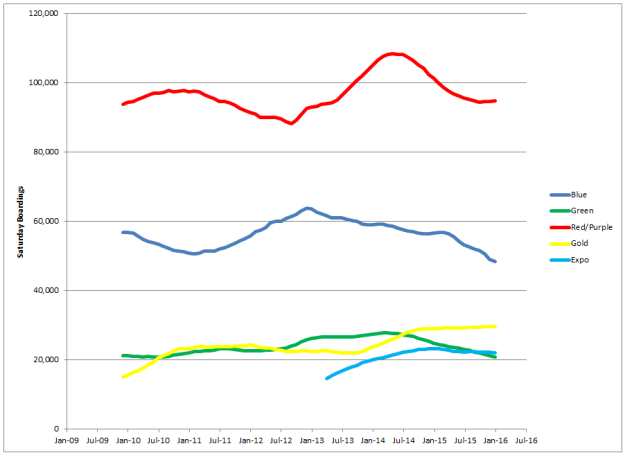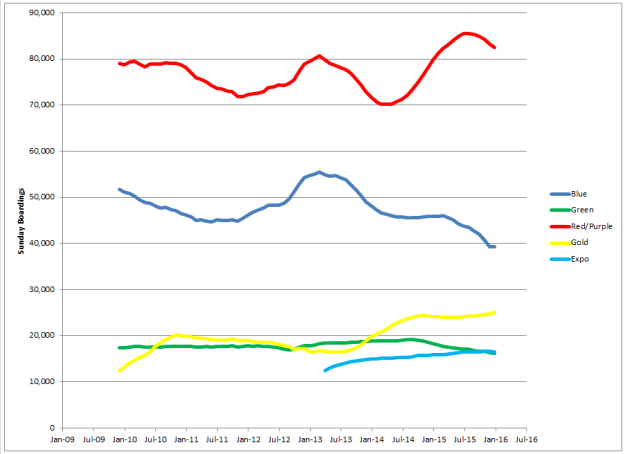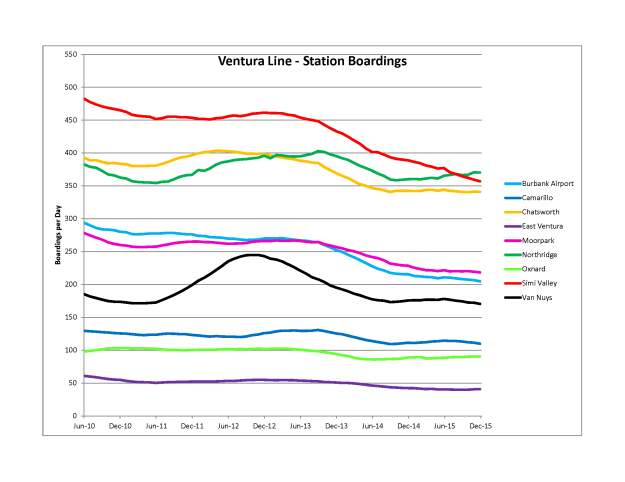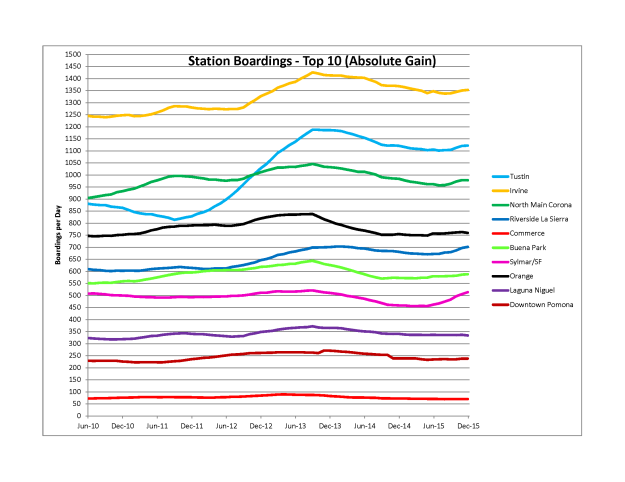Over the last few years, there has been much consternation – much of it fair, in my opinion – about the performance of the LA region’s economy over the last few decades. More dubious are the opinion pieces that look to tie this underperformance to some singular regional problem or disamenity. Since the Bay Area economy has been blazing hot, it is natural that many comparisons between SF and LA have been made.
Let’s go beyond the anecdotal level and take a closer look. Much analysis starts in 1990, perhaps because that’s the oldest data for regional (MSA) level employment information easily available from FRED. I’m adding the New York City MSA to the graphs as a reference for another large established region. (If you add a place like Houston, it’ll just blow everyone else out of the water.)
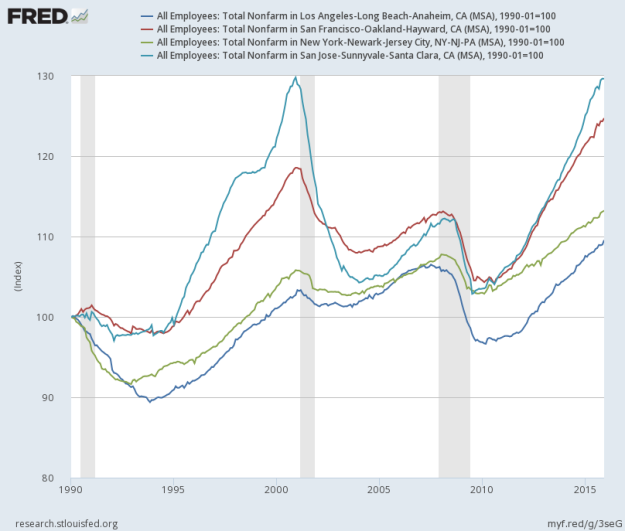
Indexed to 1990, LA has indeed done considerably worse than SF, San Jose, and NYC. However, astute observers will note that a lot of this is because LA did much worse in the early 1990s. The recession of the early 1990s did not affect all parts of the country equally; while SF and SJ more or less moved sideways, NYC and LA were really punished. In particular, LA’s defense industry was gutted by cutbacks in defense spending at the end of the Cold War. Should LA’s leaders be held accountable for the collapse of the Soviet Union? Probably not. A more reasonable comparison might therefore start at the bottom of employment in the early 1990s, in November 1993.

This simple change to the baseline date just about eliminates the argument that the Bay Area has trounced LA over the last two decades. SF and SJ race ahead with the tech boom in the 1990s, LA and NYC outperform them during the 2000s, and then SF and SJ race ahead again with the latest tech boom. The fact that LA’s economy got crushed in the early 1990s and SJ’s economy got crushed in the early 2000s is really just about regional differences in the importance of the sector that got hit the worst.
Speaking of regional differences, many comparisons ignore that LA was much more dependent on manufacturing employment in 1990 than the Bay Area and some other large cities in the US. There has been a secular decline in manufacturing employment across the US. Again, should LA’s leaders be held accountable for the fact that they had a huge legacy manufacturing sector in 1990? Probably not. An even more reasonable comparison might therefore exclude manufacturing employment.
Here’s regional employment ex manufacturing, indexed to November 1993.

In this case, LA performs a little better than SF and NYC, while SJ (which had a large tech-based manufacturing sector that got destroyed in the early 2000s) is the clear winner.
You might find it interesting that San Jose, a more outlying part of the Bay Area, performed much better than San Francisco, at its heart. And you might also think, hey, isn’t there a more outlying part of Southern California that we could also throw into the mix? And you’d be right: we could add the Inland Empire, the Riverside-San Bernardino MSA.
Here’s regional employment, indexed to November 1993, adding the IE.

Here’s regional employment ex manufacturing, indexed to November 1993, adding the IE.
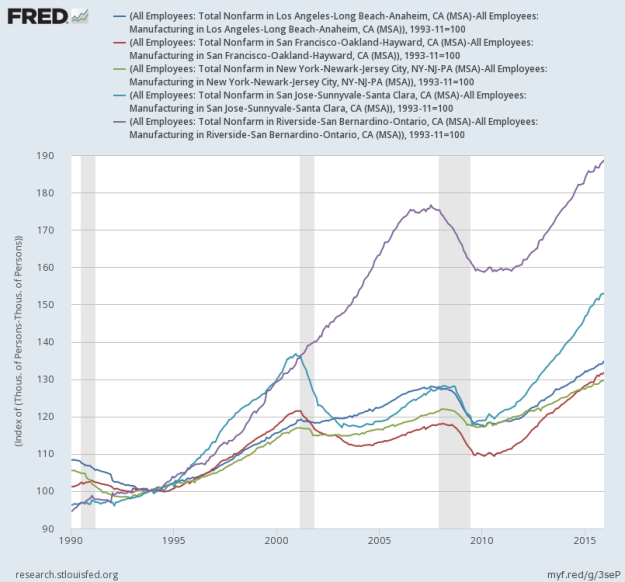
Obviously, the IE is the part of California that really has things figured out, and both SF and LA should try to be more like the IE, right?
Lastly, let’s take the combined regions SF-SJ and LA-IE. Here are the same two graphs, showing SF and SJ combined and LA and the IE combined.


SF-SJ performed a little better in the 1990s and 2010s, but overall LA-IE has done better than SF-SJ or NYC, even ignoring the impact of manufacturing employment.
Stepping back from the data, I’m not sure what to make of some of the critiques of the LA economy. Yes, many of the jobs created by investment and modernization of the ports are low wage jobs, as are the logistics jobs booming in the IE. But given the changes in global trade, all of that cargo has to come into the US somewhere. Is it such a terrible thing that it comes to LA-IE, the second largest US market, and created a ton of blue-collar jobs? Factory jobs weren’t higher-paying because factories are magic, they were higher-paying because of unions. The wages and lives of LA’s huge population of service industry workers will be greatly improved by labor organization for higher pay, which is already happening.
Likewise, the emergence of SF-SJ as the world’s tech capital instead of LA is to a large extent a random event. Do you really want to say you know why it happened at Stanford and Berkeley, not UCLA and USC, or Harvard and MIT, or even UT-Austin or Carnegie-Mellon? Really? The confluence of events that have to occur in the creation of an economic geography like Silicon Valley (or Hollywood or London) includes so many random outcomes, you can hardly credit one region’s leaders for becoming an industry hub or fault another region’s leaders for not doing so. Apple Computers survived, Wang Computers did not, and it didn’t have a damn thing to do with city governance in Cupertino or Lowell.
Furthermore, only a few cities will get to be dominant in any particular industry. SF-SJ and a few other cities can be heavily concentrated in tech, but everyone can’t be. Many other cities can have thriving, but small, tech sectors. All cities will have a small banking sector; very few will be New York or London or Tokyo. If LA had emerged as a tech capital and the Bay Area had been left behind, would California as a whole be better off?
It can be very hard to disrupt economic geographies once they’re established. At this point, New York and London are capitals of the finance industry simply because they’ve always been capitals of the finance industry. Hollywood is Hollywood because it’s been Hollywood for a century. It’s not that you can’t make a successful movie somewhere else, but the labor skills and institutional know-how already available in LA make it a natural fit for people who want to do that.
It’s not hard to believe that at this point, the Bay Area is the tech capital just because it is. In a positive feedback loop, people go there for the tech industry because that’s where the industry is and the industry goes there because that’s where the people are. If he did anything, Benedict Evans laid to rest the idea that all the techies are drawn to San Francisco by something else.
It’s also not hard to believe that, if another tech crash comes, many of the people now singing the Bay Area’s praises will point out that the region was dangerously concentrated in software development. Look back at those charts: no region soared as high or crashed as quickly as Silicon Valley. But if it’s unclear what LA’s leaders should have done to develop a larger tech sector, it’s equally unclear what the Bay Area’s leaders should be doing to cool the tech boom and diversify the economy. Economic geographies are complex, and ultimately, no one really knows what caused a particular sector in a particular region to grow or not grow.
None of this is to say that there aren’t things to worry about in the LA economy. Wage growth for low-income households has been dismal, and the IE in particular has seen very low wage growth. The high cost of housing makes the region less competitive and makes it harder to start a business or attract workers.
Not coincidentally, all of this strongly supports upzoning. Since we don’t really know how to make a particular sector in a particular region grow, it’s all the more important to let people take advantage of economic opportunity where it exists. That doesn’t mean that there won’t be successful enterprises in many different sectors in many different cities; it just means that to give the most people the best chance to improve their lives, we should allow them to live and start businesses in all of the places where economic opportunity exists.

